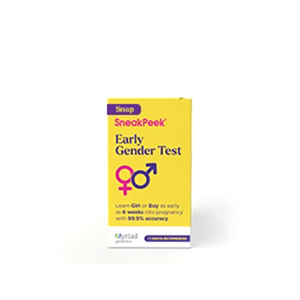Published on September 10th, 2023 and Updated on January 15th, 2024
Check out SneakPeek Gender Test to find out your baby’s gender as early as 6 weeks at over 99% accuracy1!
If you’re currently dealing with fertility issues, know that you’re not alone—some 15% of couples struggle to conceive naturally. And an estimated 33% of these cases are caused by male fertility challenges, which can result from a variety of semen and sperm-related issues.
Low sperm count is one of them, though you may hear doctors refer to it as oligospermia or oligozoospermia. By this definition, a man has fewer than 15 million sperm per millimeter when semen is examined under a microscope.
While having a low sperm count doesn’t always warrant clinical intervention, understanding what factors can depress sperm volume production and, in turn, understanding how to produce more healthy sperm, can help you or your partner make lifestyle changes that could improve your chances of conceiving. Read on for some guidance on increasing sperm count and how to produce more sperm.
What factors can cause a low sperm count?
Fertility science is tremendously complex, as it takes two healthy reproductive systems to conceive new life. Possessing a sufficient quantity of sperm is one critical variable. The two others are:
- Sperm motility – Sperm cells need to be physically fit enough to swim toward and reach an egg dispatched from a woman’s uterus. A sperm cell’s ability to move is called sperm motility. So long as 40% of sperm can navigate toward the egg, sperm motility is considered viable.
- Sperm morphology – This refers to the physical structure of the sperm cell. While their structures are simple, sperm cells need a head and a tail to help them swim. If the majority of sperm are normally structured, sperm is considered relatively healthy.
Male fertility requires the relative health of all three factors. But whether you’ve been evaluated by a fertility specialist already or just want to promote fertility and sexual health between the two of you, it helps to understand the causal factors behind poor sperm volume production specifically.
Age
Sperm count, semen volume, testosterone level, and semen quality in general, tend to diminish as men get older. They begin to decline around the age of 50.
Overall Health
Sexual function is considered a marker of overall health. Several health concerns may have the effect of inhibiting sperm production, including:
- Being overweight or obese
- Having recently had, or recovered from, surgery or trauma
- Living with a sexually transmitted infection (STI)
- Mental health issues, like struggling with depression
- Excessive use of substances like alcohol or recreational drugs
- Tobacco use or vaping
- Immune disorders
- Chronic stress
Taking certain medications for a chronic or preexisting health condition may likewise depress sperm production. If you or your partner is taking medication, it’s best to consult with your doctor to determine whether the drug has any reproductive side effects.
Environment
A handful of environmental factors have been linked to decreased semen volume and sperm count. For instance, exposure to certain chemicals like heavy metals or pesticides can put men at risk of decreased sperm production. Extremely high temperatures may also depress the body’s ability to produce sperm and may lead to male infertility.
Behavior and Lifestyle
Certain lifestyle factors are thought to play a role in diminished sperm count. Men who take testosterone, steroids, or other “workout boosters” to build muscle mass may inadvertently suppress sperm growth.
Similarly, certain occupations may make it more difficult for the body to produce sufficient sperm. This predominantly includes jobs that require a significant amount of driving or sitting down for hours at a time.
7 Approaches for Enhancing Sperm Production
If you’re struggling to conceive but aren’t ready to see a specialist yet, it may be worth making some effective but non-invasive changes to help give your sperm a boost. Below, find 7 ways to tackle the issue before seeking clinical guidance.
#1 If You’re Heavier, Consider Losing Weight
Numerous studies have demonstrated a negative association between excess body weight and sperm quantity and quality. If you’re struggling with fertility challenges and are carrying extra weight, losing weight and eating a healthier diet overall may be an excellent place to start.
#2 Incorporate Regular Movement
Studies examining the negative connection between excess weight and male fertility tend to indicate subjects possess a relatively sedentary lifestyle. Indeed, regular exercise is routinely cited as an important factor in boosting male sexual health and male fertility: not only can it promote testosterone production, but it may also help enhance semen quality, too.
#3 Take a Break from Alcohol
While alcohol has long been used as a celebratory beverage, the scientific community largely agrees that the substance can have “significant” impacts on reproductive function in both sexes. The adverse consequences of excessive drinking are demonstrated in:
- Impaired paternal semen quality – Several studies have shown that chronic or heavy drinkers express poorer semen quality (in quantity, motility, and morphology) than moderate drinkers. Not only may alcohol impact overall sperm quality, but it may also link to DNA breakdown within individual sperm cells themselves.
- Higher risk of developmental problems in offspring – Other studies suggest that children of paternal heavy drinkers demonstrate reproductive, hormonal, and other abnormalities in their development.
As a reminder, these are the current benchmarks for gauging heavy drinking habits:
- Men – 15 or more drinks per week
- Women – 8 or more drinks per week
If you’re concerned about your or a partner’s alcohol use, a trusted healthcare provider can counsel you on options for recovery.
#4 Boost Your Vitamin C Intake
One small study points to vitamin C’s potential to promote sperm health. In the study, men between 25 and 35 struggling with fertility took 1000mg of vitamin C daily for 2 months. The results showed a significant improvement in sperm health on all three fronts: quantity, quality, and motility.
While vitamin C is known to be an immune system ally, it’s also known to be a potent antioxidant. Researchers believe that the nutrient’s ability to combat oxidative stress—thought to be a primary driver of male infertility—is responsible for its effects on increasing sperm count.
#5 Take an Herbal Approach
Several traditional herbs have been shown to promote fertility in men. These can be taken in crude or supplement form. Some of the most potent ones include:
- Ashwagandha – Ashwagandha is an Indian herb that assists with enhancing testosterone level in men. In one study, men who took 675mg of daily ashwagandha root extract for 3 months showed a remarkable 167% increase in sperm counts.
- Maca root – The Peruvian plant maca root has likewise demonstrated fertility-enhancing properties. In one 12-week study, participants who consumed 1.75 grams of maca root per day demonstrated improved sperm count and motility alike.
#6 Up Your Zinc Intake
One paper from the Journal of Reproduction & Infertility called zinc an “essential element” in promoting male fertility. Men who exhibit low levels of the mineral in their semen display lower-quality sperm than those who have it in substantial amounts.
Adequate zinc is crucial for spermatogenesis, the process through which sperm are produced and develop morphologically healthy. But, because the human body can’t store zinc, the mineral must be ingested orally, either as food or in supplement form.
To boost your diet accordingly, consider filling your plate with the following zinc-dense foods:
- Red meats, like steak, pork, and lamb
- Shellfish, like oysters, Alaska king crab, and mussels
- Legumes, like chickpeas and lentils
- Nuts and seeds, like peanuts, hemp seeds, and cashews
#7 Take Stock of Daily Habits
Women’s reproductive equipment enjoys relative concealment in comparison with men’s. So, it’s no surprise certain lifestyle habits are suspected to contribute to lower sperm counts or quality.
The following seemingly subtle behavioral changes may help improve sperm count:
- Wearing looser underwear – Tight-fitting underwear may depress sperm production.
- Cut down on biking – Cycling more than 5 hours per week may inhibit sperm production.
- Favoring cooler environments – Spending a lot of time in heated environments may compromise sperm quality.
- Staying away from toxic chemicals – Mounting evidence suggests exposure to hormone-disrupting chemicals and toxins, like pesticides or paint strippers, may interfere with both male and female fertility.
When should you see a fertility specialist?
If you and your partner are still struggling to conceive after one year of trying, it may be time to seek assistance from a professional. Fertility specialists can help you assess the reproductive health of both partners, as well as the potential causes of your challenges.
At times (though not always), men with lower sperm count may notice related symptoms of sexual dysfunction. These might include:
- Difficulty maintaining erection
- Low libido
- Pain, soreness, or swelling around the genitals
That said, it’s not uncommon for the discovery of lower-than-average sperm to come as a surprise. Fortunately, there are many treatment options available, including:
- Behavioral changes to reverse impaired semen quality or the factors underpinning it
- Surgery to correct anatomical abnormalities contributing to infertility
- Hormonal therapies to correct imbalances compromising healthy sperm production
- Assistive reproductive technologies (ART) to help you and your partner conceive—even if you’re found to have significantly prohibitive fertility issues
Support Your Fertility Journey with SneakPeek
Everyone’s journey to parenthood is different, and everyone encounters some obstacles along the way. Fortunately, fertility science can offer actionable solutions and support as hopeful parents figure out what their path to growing their family looks like.
Once you’ve reached the next stage, SneakPeek’s Early Gender Blood Test can introduce you to your little one earlier than expected. In fact, as early as 6 weeks into pregnancy, this DNA-based test can reveal your future baby’s gender with over 99% clinically proven accuracy1.
Simply take the test at home and send your sample to SneakPeek labs. Then, we’ll triple-review and send your SneakPeek Test results on the same day we get them with total privacy protection.
SneakPeek is OBGYN’s #1 recommended at-home early gender blood test, trusted by 1 million happy new moms. Get more insight on your new arrival by visiting SneakPeek today.
Sources:
- National Institutes of Health. How common is male infertility, and what are its causes? https://www.nichd.nih.gov/health/topics/menshealth/conditioninfo/infertility
- Cleveland Clinic. Oligospermia (Low Sperm Count). https://my.clevelandclinic.org/health/diseases/22477-oligospermia-low-sperm-count
- Mayo Clinic. Healthy sperm: Improving your fertility. https://www.mayoclinic.org/healthy-lifestyle/getting-pregnant/in-depth/fertility/art-20047584
- Healthline. What Causes Low Sperm Count and How Is It Treated? https://www.healthline.com/health/infertility/low-sperm-count#causes
- Healthline. 10 Ways to Boost Male Fertility and Increase Sperm Count. https://www.healthline.com/health/boost-male-fertility-sperm-count
- National Institutes of Health. Impact of Alcohol Consumption on Male Fertility Potential: A Narrative Review. https://www.ncbi.nlm.nih.gov/pmc/articles/PMC8751073/
- National Institute on Alcohol Abuse and Alcoholism. The Basics: Defining How Much Is Too Much. https://www.niaaa.nih.gov/health-professionals-communities/core-resource-on-alcohol/basics-defining-how-much-alcohol-too-much
- National Library of Medicine. Increased physical activity has a greater effect than reduced energy intake on lifestyle modification-induced increases in testosterone. https://pubmed.ncbi.nlm.nih.gov/26798202/
- National Library of Medicine. Physically active men show better semen parameters and hormone values than sedentary men. https://pubmed.ncbi.nlm.nih.gov/22234399/
- National Library of Medicine. Clinical Evaluation of the Spermatogenic Activity of the Root Extract of Ashwagandha (Withania somnifera) in Oligospermic Males: A Pilot Study. https://pubmed.ncbi.nlm.nih.gov/24371462/
- National Library of Medicine. Effect of Lepidium meyenii Walp. on Semen Parameters and Serum Hormone Levels in Healthy Adult Men: A Double-Blind, Randomized, Placebo-Controlled Pilot Study. https://pubmed.ncbi.nlm.nih.gov/26421049/
- National Library of Medicine. Improvement in human semen quality after oral supplementation of vitamin C. https://pubmed.ncbi.nlm.nih.gov/17004914/
- Healthline. 7 Tips for Healthy Sperm. https://www.healthline.com/health/fertility/how-to-increase-sperm-count#healthy-sperm
- National Library of Medicine. Zinc is an Essential Element for Male Fertility: A Review of Zn Roles in Men’s Health, Germination, Sperm Quality, and Fertilization. https://www.ncbi.nlm.nih.gov/pmc/articles/PMC6010824/
- Healthline. The 10 Best Foods That Are High in Zinc. https://www.healthline.com/nutrition/best-foods-high-in-zinc#TOC_TITLE_HDR_3
- Mayo Clinic. Low sperm count. https://www.mayoclinic.org/diseases-conditions/low-sperm-count/symptoms-causes/syc-20374585

Shop Our Products
SneakPeek aims to provide the most accurate and up-to-date information to help our readers make informed decisions regarding their health before, during, and after pregnancy. This article was written based upon trusted scientific research studies and/or articles. Credible information sources for this article are cited and hyperlinked.





